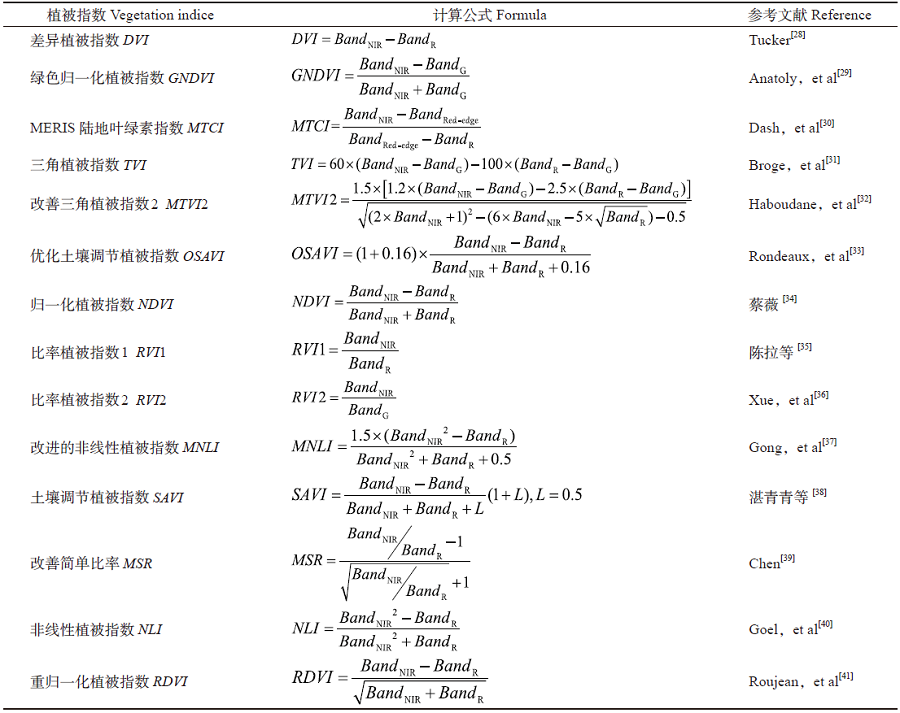| [1] |
董泰锋, 蒙继华, 吴炳方. 基于遥感的光合有效辐射吸收比率(FAPAR)估算方法综述. 生态学报, 2012,32(22):7190-7201.
|
| [2] |
周元刚. 不同受旱条件下冬小麦和夏玉米冠层光截获特征研究. 杨凌:西北农林科技大学, 2016.
|
| [3] |
李贺丽, 罗毅, 薛晓萍, 等. 冬小麦冠层对入射光合有效辐射吸收比例的估算方法评价. 农业工程学报, 2011,27(4):201-206.
|
| [4] |
Moriondo M, Maselli F, Bindi M. A simple model of regional wheat yield based on NDVI data. European Journal of Agronomy, 2007,26(3):266-274.
|
| [5] |
张宇. 基于光学和雷达遥感的水稻FAPAR协同反演. 成都:电子科技大学, 2019.
|
| [6] |
Zhang Y, Li S, He Z, et al. Synergistic Inversion of Rice FPAR Based on Optical and Radar Remote Sensing Data. IGARSS 2019-2019 IEEE International Geoscience and Remote Sensing Symposium. IEEE, 2019.
|
| [7] |
王方永, 韩焕勇, 陈兵, 等. 数字图像估测棉花光合有效辐射吸收比例. 西北农业学报, 2015,24(10):74-79.
|
| [8] |
Majasalmi T, Stenberg P, Rautiainen M. Comparison of ground and satellite-based methods for estimating stand-level fPAR in a boreal forest. Agricultural and Forest Meteorology, 2017,232:422-432.
|
| [9] |
Liang S, Hou X, Sui X, et al. Deciduous broadleaf forests green FPAR and its relationship with spectral vegetation indices. 2017 10th International Congress on Image and Signal Processing,BioMedical Engineering and Informatics (CISP-BMEI). IEEE, 2017.
|
| [10] |
Tan C W, Wang D L, Zhou J, et al. Remotely assessing fraction of photosynthetically active radiation (FAPAR) for wheat canopies based on hyperspectral vegetation indexes. Frontiers in Plant Science, 2018,9:776.
|
| [11] |
Dong T, Meng J, Shang J, et al. Evaluation of chlorophyll-related vegetation indices using simulated sentinel-2 data for estimation of crop fraction of absorbed photosynthetically active radiation. IEEE Journal of Selected Topics in Applied Earth Observations and Remote Sensing, 2015,8(8):4049-4059.
|
| [12] |
刘桂鹏, 贺婷, 王国骄, 等. 玉米LAI和FAPAR的高光谱遥感预测模型研究. 玉米科学, 2016,24(2):115-119,128.
|
| [13] |
田春燕, 黄春燕, 郭晓飞, 等. 基于植被指数的棉花冠层光合有效辐射截获量和叶片净光合速率估算研究. 新疆农业科学, 2017,54(6):981-987.
|
| [14] |
Qin H M, Wang C, Zhao K G, et al. Estimation of the fraction of absorbed photosynthetically active radiation (FAPAR) in maize canopies using LiDAR data and hyperspectral imagery. PLoS ONE, 2018,13(5):e0197510.
|
| [15] |
Zhao L, Liu Z G, Xu S, et al. Retrieving the diurnal FAPAR of a maize canopy from the jointing stage to the tasseling stage with vegetation indices under different water stresses and light conditions. Sensors, 2018,18(11):3965.
|
| [16] |
万亮, 岑海燕, 朱姜蓬, 等. 基于纹理特征与植被指数融合的水稻含水量无人机遥感监测. 智慧农业(中英文), 2020,2(1):58-67.
|
| [17] |
张华, 张玉红, 张改改. 民勤绿洲青土湖植被优势种地上生物量估算. 干旱区地理, 2020,43(1):201-210.
|
| [18] |
陈鹏, 冯海宽, 李长春, 等. 无人机影像光谱和纹理融合信息估算马铃薯叶片叶绿素含量. 农业工程学报, 2019,35(11):63-74.
|
| [19] |
高凯旋, 焦海明, 王新闯. 融合影像纹理、光谱与地形特征的森林冠顶高反演模型. 国土资源遥感, 2020,32(3):63-70.
|
| [20] |
谢士琴, 赵天忠, 王威, 等. 结合影像纹理、光谱与地形特征的森林结构参数反演. 农业机械学报, 2017,48(4):125-134.
|
| [21] |
蔡文婷, 赵书河, 王亚梅, 等. 结合Sentinel-2光谱与纹理信息的冬小麦作物茬覆盖度估算. 遥感学报, 2020,24(9):1108-1119.
|
| [22] |
贾丹, 陈鹏飞. 低空无人机影像分辨率对冬小麦氮浓度反演的影响. 农业机械学报, 2020,51(7):164-169.
|
| [23] |
蒙诗栎, 庞勇, 张钟军, 等. WorldView-2纹理的森林地上生物量反演. 遥感学报, 2017,21(5):812-824.
|
| [24] |
杨俊, 丁峰, 陈晨, 等. 小麦生物量及产量与无人机图像特征参数的相关性. 农业工程学报, 2019,35(23):104-110.
|
| [25] |
Wulder M A, LeDrew. Aerial image texture information in the estimation of northern deciduous and mixed wood forest leaf area index (LAI). Remote Sensing of Environment, 1998,64(1):64-76.
|
| [26] |
Cen H, Wan L, Zhu J, et al. Dynamic monitoring of biomass of rice under different nitrogen treatments using a lightweight UAV with dual image-frame snapshot cameras. Plant Methods, 2019,15(1):32.
|
| [27] |
Wan L, Li Y, Cen H, et al. Combining UAV-based vegetation indices and image classification to estimate flower number in oilseed rape. Remote Sensing, 2018,10(9):1484.
|
| [28] |
Tucker C J. Red and photographic infrared linear combinations for monitoring vegetation. Remote Sensing of Environment, 1979,8(2):127-150.
|
| [29] |
Anatoly A G, Merzlyak M N. Remote sensing of chlorophyll concentration in higher plant leaves. Advances in Space Research, 1998,22(5):689-692.
|
| [30] |
Dash J, Curran P J. The MERIS terrestrial chlorophyll index. International Journal of Remote Sensing, 2004,25(23):5403-5413.
|
| [31] |
Broge N H, Leblanc E. Comparing prediction power and stability of broadband and hyperspectral vegetation indices for estimation of green leaf area index and canopy chlorophyll density. Remote Sensing of Environment, 2001,76(2):156-172.
|
| [32] |
Haboudane D, Miller J R, Pattey E, et al. Hyperspectral vegetation indices and novel algorithms for predicting green LAI of crop canopies: modeling and validation in the context of precision agriculture. Remote Sensing of Environment, 2004,90(3):337-352.
|
| [33] |
Rondeaux G, Steven M, Baret F. Optimization of soil-adjusted vegetation indices. Remote Sensing of Environment, 1996,55(2):95-107.
|
| [34] |
蔡薇. 基于NDVI时间序列的荷泽市东明县植被动态变化研究. 经济研究导刊, 2009(18):136-137.
|
| [35] |
陈拉, 黄敬峰, 王秀珍. 不同传感器的模拟植被指数对水稻叶面积指数的估测精度和敏感性分析. 遥感学报, 2008(1):143-151.
|
| [36] |
Xue L, Cao W, Luo W, et al. Monitoring leaf nitrogen status in rice with canopy spectral reflectance. Agronomy Journal, 2004,96(1):135-142.
|
| [37] |
Gong P, Pu R, Biging G S, et al. Estimation of forest leaf area index using vegetation indices derived from hyperion hyperspectral data. IEEE Transactions on Geoscience and Remote Sensing, 2003,41(6):1355-1362.
|
| [38] |
湛青青, 王辉源. 基于综合指数分析的城市建筑用地信息提取研究. 测绘与空间地理信息, 2014,37(2):62-65,69.
|
| [39] |
Chen J M. Evaluation of vegetation indices and a modified simple ratio for boreal applications. Canadian Journal of Remote Sensing, 1996,22(3):229-242.
|
| [40] |
Goel N S, Qin W H. Influences of canopy architecture on relationships between various vegetation indices and LAI and FPAR: A computer simulation. Remote Sensing Reviews, 1994,10(4):309-347.
|
| [41] |
Roujean J L, Breon F M. Estimating PAR absorbed by vegetation from bidirectional reflectance measurements. Remote Sensing of Environment, 1995,51(3):375-384.
|
| [42] |
Sun Q, Sun L, Shu M, et al. Monitoring maize lodging grades via unmanned aerial vehicle multispectral image. Plant Phenomics, 2019(2):1-16.
|
| [43] |
刘思涵. 基于高分辨率影像纹理特征的落叶松人工林提取研究. 西安:西安科技大学, 2020.
|
| [44] |
刘畅, 杨贵军, 李振海, 等. 融合无人机光谱信息与纹理信息的冬小麦生物量估测. 中国农业科学, 2018,51(16):3060-3073.
|
 ), Nie Chenwei2, Yu Xun2,3, Shao Mingchao2,4, Wang Zixu2,5, Nuremanguli· Tuohuti2,6, Liu Yadong2, Cheng Minghan2,7, Guan Yunlan1(
), Nie Chenwei2, Yu Xun2,3, Shao Mingchao2,4, Wang Zixu2,5, Nuremanguli· Tuohuti2,6, Liu Yadong2, Cheng Minghan2,7, Guan Yunlan1( ), Jin Xiuliang2(
), Jin Xiuliang2( )
)







